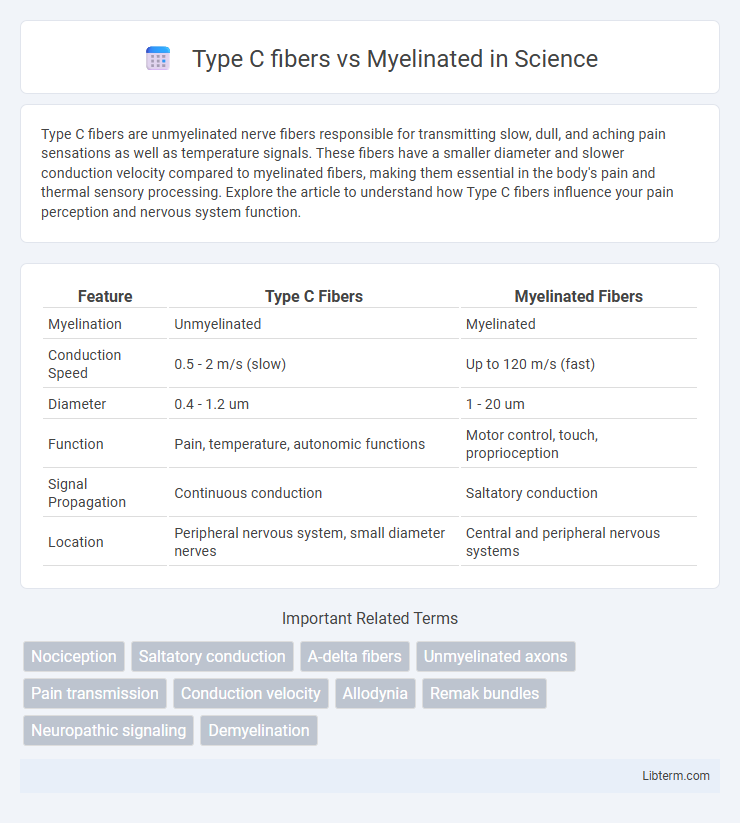Type C fibers are unmyelinated nerve fibers responsible for transmitting slow, dull, and aching pain sensations as well as temperature signals. These fibers have a smaller diameter and slower conduction velocity compared to myelinated fibers, making them essential in the body's pain and thermal sensory processing. Explore the article to understand how Type C fibers influence your pain perception and nervous system function.
Table of Comparison
| Feature | Type C Fibers | Myelinated Fibers |
|---|---|---|
| Myelination | Unmyelinated | Myelinated |
| Conduction Speed | 0.5 - 2 m/s (slow) | Up to 120 m/s (fast) |
| Diameter | 0.4 - 1.2 um | 1 - 20 um |
| Function | Pain, temperature, autonomic functions | Motor control, touch, proprioception |
| Signal Propagation | Continuous conduction | Saltatory conduction |
| Location | Peripheral nervous system, small diameter nerves | Central and peripheral nervous systems |
Introduction to Nerve Fiber Types
Type C fibers are unmyelinated nerve fibers characterized by slow conduction velocities and small diameters, primarily responsible for transmitting dull, aching pain and temperature sensations. In contrast, myelinated fibers, including Ad and Ab types, have larger diameters and faster conduction speeds, facilitating rapid transmission of sharp pain, touch, and proprioceptive signals. Understanding the differences between Type C and myelinated fibers is essential for comprehending sensory processing and pain mechanisms within the peripheral nervous system.
What Are Type C Fibers?
Type C fibers are unmyelinated nerve fibers that transmit slow, chronic pain and temperature signals from peripheral tissues to the central nervous system. Unlike myelinated fibers, Type C fibers have smaller diameters and slower conduction velocities, typically around 0.5-2 meters per second. These characteristics enable Type C fibers to mediate dull, diffuse pain sensations and autonomic functions, contrasting with the rapid, sharp pain signals carried by myelinated A-delta fibers.
Characteristics of Myelinated Nerve Fibers
Myelinated nerve fibers are characterized by the presence of a myelin sheath, which significantly increases the speed of electrical impulse conduction through saltatory conduction. Unlike unmyelinated Type C fibers, myelinated fibers have larger diameters and faster transmission rates, typically ranging from 5 to 120 meters per second. These fibers are crucial for rapid signal transmission in motor and sensory pathways, enabling efficient communication within the nervous system.
Structural Differences: Type C vs Myelinated Fibers
Type C fibers are unmyelinated nerve fibers characterized by small diameters and slow conduction velocities, contrasting with myelinated fibers that possess a fatty myelin sheath enabling rapid signal transmission. The myelin sheath in myelinated fibers is formed by Schwann cells, which wrap around the axon in multiple layers, enhancing electrical insulation and saltatory conduction. Type C fibers lack this insulating layer, resulting in continuous conduction and delayed impulse propagation compared to the segmented, efficient conduction observed in myelinated fibers.
Conduction Speed and Signal Transmission
Type C fibers, unmyelinated and smaller in diameter, exhibit slower conduction speeds typically around 0.5 to 2 meters per second, resulting in delayed signal transmission compared to myelinated fibers. Myelinated fibers utilize saltatory conduction, where action potentials jump between nodes of Ranvier, significantly increasing conduction velocity up to 120 meters per second. The enhanced efficiency of myelinated fibers enables rapid and precise communication essential for motor control and sensory processing.
Pain Perception: Role of Type C and Myelinated Fibers
Type C fibers are unmyelinated and responsible for transmitting slow, dull, and persistent pain signals, often associated with chronic pain perception. Myelinated fibers, such as A-delta fibers, conduct fast, sharp, and well-localized pain sensations due to their rapid signal transmission capabilities. The paired function of these fibers facilitates a comprehensive pain response, with myelinated fibers managing immediate reflexive reactions and Type C fibers modulating prolonged discomfort.
Functional Roles in the Nervous System
Type C fibers are unmyelinated nerve fibers responsible for transmitting slow, dull, and diffuse pain signals, as well as temperature and autonomic functions in the nervous system. Myelinated fibers, including A-delta and A-beta fibers, conduct rapid, sharp pain and precise touch sensations due to their myelin sheath, which facilitates faster signal transmission. These functional roles differentiate their contributions to sensory processing and reflex responses within peripheral and central nervous pathways.
Clinical Implications and Disorders
Type C fibers, unmyelinated and slow-conducting, are primarily responsible for transmitting dull, aching pain and temperature sensations, making them crucial in chronic pain conditions such as neuropathic pain and fibromyalgia. In contrast, myelinated A-delta fibers conduct sharp, acute pain signals rapidly, playing a key role in protective reflexes and acute injury response, with dysfunction linked to neuropathies like multiple sclerosis and diabetic neuropathy. Clinical implications include targeted treatments where Type C fiber modulation can alleviate chronic pain syndromes, while preserving myelinated fibers is essential to maintain sensory and motor function integrity in demyelinating diseases.
Research Advances on Nerve Fiber Differences
Recent research advances highlight that Type C fibers are unmyelinated, exhibiting slower conduction velocities compared to myelinated fibers, which enable rapid signal transmission through saltatory conduction. Studies emphasize molecular differences, such as the distinct expression of ion channels and neuropeptides in Type C fibers, influencing pain signaling and inflammatory responses. Innovative imaging techniques and electrophysiological analysis have deepened understanding of the functional heterogeneity between unmyelinated Type C fibers and their myelinated counterparts in sensory and autonomic pathways.
Summary: Key Takeaways on Type C vs Myelinated Fibers
Type C fibers are unmyelinated, small-diameter nerve fibers that conduct impulses slowly and are primarily responsible for transmitting dull, aching pain and temperature sensations. Myelinated fibers, such as A-delta fibers, have a thicker diameter and a myelin sheath that allows rapid conduction of sharp, acute pain and precise touch signals. Understanding the differences in conduction speed, fiber diameter, and myelination is crucial for differentiating sensory processing and pain perception mechanisms in the nervous system.
Type C fibers Infographic

 libterm.com
libterm.com